Hebrew Search Comes to Olive Tree iPhone Bible Reader Beta
12/13/2008 07:31 Filed in: Faith & Reason | Technology
Earlier this week I posted a screenshot of a basic Greek word search in the Olive Tree iPhone beta. Since then Olive Tree has released the ability to do a basic search of Hebrew texts as well:
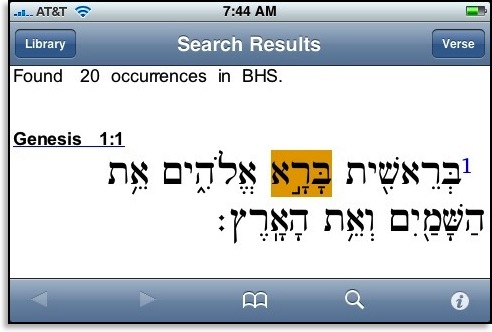
I’ve also found that reading Hebrew on the iPhone works better in landscape mode.
Again, this is still just a beta. Olive Tree has a number English texts already available (go to the iTunes store and search for “Olive Tree” ).

I’ve also found that reading Hebrew on the iPhone works better in landscape mode.
Again, this is still just a beta. Olive Tree has a number English texts already available (go to the iTunes store and search for “Olive Tree” ).
|
First Look: Hebrew & Greek Biblical Texts on the iPhone
10/24/2008 08:29 Filed in: Faith & Reason | Technology
For my initial review of Olive Tree’s Bible Reader for the iPhone, go here.
The screen shots below are from a beta released yesterday from Olive Tree (I have permission to post these images):
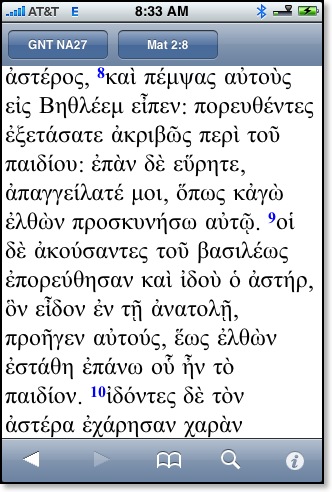

Frequent readers of This Lamp will know that I’ve lamented the loss of original language biblical texts “in my pocket” ever since switching from my Palm Treo to the iPhone last year. After a long wait, Olive Tree comes through with the promise a full replacement, and I have to admit that the texts look much better here than they ever did on my former device.
As you would expect, these texts are fully downloaded to the iPhone and do not require an internet connection for repeated access.
While I’ve got your attention, let me show you a couple of other things Olive Tree is working on for their Bible Reader.
Since my initial review, Olive Tree has incorporated links to textual notes and cross references in their modules.
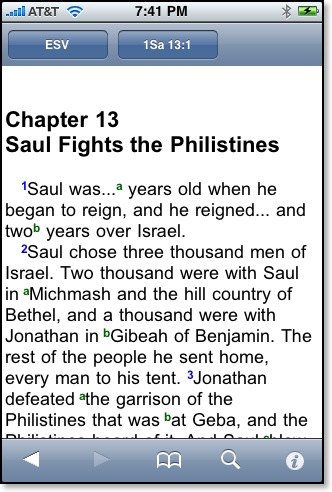

For instance, as demonstrated in the above modules, clicking/touching the superscript letters in the ESV leads to a appropriate section in the ESV notes. This is still not split screen, which I would prefer, but it’s a good start.
Traditionally, Olive Tree has allowed users who purchased texts for one platform to download these on any other platform as well. For instance, after purchasing modules for the Palm years ago, I was also able to download the same texts to a Windows Mobile device while I was testing one out a while back. However, this generous level of cross platform mobility has not been possible so far with the iPhone because Apple tightly controls iPhone apps and requires them to be distributed via the iTunes Store only with the exception of beta releases as seen in some of the images here). And not only do previously purchased modules have to be re-purchased, they have to be purchased separately. Again, this is not a policy from Olive Tree, but rather from Apple.
Right now, for instance, if an iPhone user purchases the NIV Family Pack for Bible Reader and the ESV Study Bundle, two separate installations of the Bible Reader are loaded with each respective set of modules. Other text reader programs in the iTunes App Store have been allowed to include modular purchases, so Olive Tree is trying to work with Apple to make the same kind of access available to users of their Bible Reader.
These screen shots below from a beta release (features not yet approved by Apple) show a “store” from Olive Tree where users could purchase texts directly for download over the internet to their iPhones. Once texts have been purchased and downloaded, they show up on a “My Olive Tree Account” page.
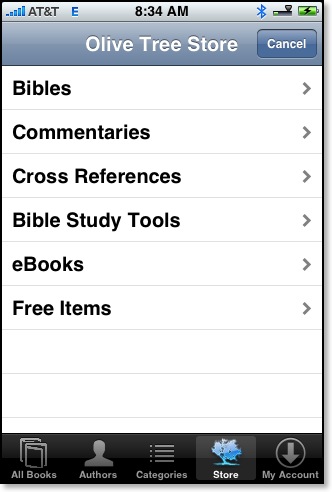




Let’s hope that Apple will approve Olive Tree’s solution because it’s a good and fair answer to the current modular dilemma.
See also:
• Olive Tree’s iPhone page
• To see Olive Tree’s current offerings in iTunes, search for “Olive Tree” in the iTunes Store Search window.
Then in the “Applications” box, select “See All.”
The screen shots below are from a beta released yesterday from Olive Tree (I have permission to post these images):


Frequent readers of This Lamp will know that I’ve lamented the loss of original language biblical texts “in my pocket” ever since switching from my Palm Treo to the iPhone last year. After a long wait, Olive Tree comes through with the promise a full replacement, and I have to admit that the texts look much better here than they ever did on my former device.
As you would expect, these texts are fully downloaded to the iPhone and do not require an internet connection for repeated access.
While I’ve got your attention, let me show you a couple of other things Olive Tree is working on for their Bible Reader.
Since my initial review, Olive Tree has incorporated links to textual notes and cross references in their modules.


For instance, as demonstrated in the above modules, clicking/touching the superscript letters in the ESV leads to a appropriate section in the ESV notes. This is still not split screen, which I would prefer, but it’s a good start.
Traditionally, Olive Tree has allowed users who purchased texts for one platform to download these on any other platform as well. For instance, after purchasing modules for the Palm years ago, I was also able to download the same texts to a Windows Mobile device while I was testing one out a while back. However, this generous level of cross platform mobility has not been possible so far with the iPhone because Apple tightly controls iPhone apps and requires them to be distributed via the iTunes Store only with the exception of beta releases as seen in some of the images here). And not only do previously purchased modules have to be re-purchased, they have to be purchased separately. Again, this is not a policy from Olive Tree, but rather from Apple.
Right now, for instance, if an iPhone user purchases the NIV Family Pack for Bible Reader and the ESV Study Bundle, two separate installations of the Bible Reader are loaded with each respective set of modules. Other text reader programs in the iTunes App Store have been allowed to include modular purchases, so Olive Tree is trying to work with Apple to make the same kind of access available to users of their Bible Reader.
These screen shots below from a beta release (features not yet approved by Apple) show a “store” from Olive Tree where users could purchase texts directly for download over the internet to their iPhones. Once texts have been purchased and downloaded, they show up on a “My Olive Tree Account” page.





Let’s hope that Apple will approve Olive Tree’s solution because it’s a good and fair answer to the current modular dilemma.
See also:
• Olive Tree’s iPhone page
• To see Olive Tree’s current offerings in iTunes, search for “Olive Tree” in the iTunes Store Search window.
Then in the “Applications” box, select “See All.”
Biblical Fonts on the iPhone: Greek--YES! Hebrew--NO!
07/20/2007 00:41 Filed in: Faith & Reason | Technology
Yesterday, I read on iPhone Central that Arabic and Hebrew fonts are not displaying correctly in the iPhone's Safari web browser (see "iPhone lacking Unicode support for Arabic, Hebrew").
As I said in my post yesterday reviewing Bible apps on the iPhone, I would like to eventually see original language biblical texts on the iPhone in addition to the English translations already available. So I decided to conduct a couple of tests on my own. If the iPhone won't display Hebrew, will it display Greek?
First, I wanted to confirm the lack of Hebrew character support, so I ran over to Iyov's blog where I remember he used some Hebrew fonts last Monday in regard to a post by yours truly. Below is an actual photograph of my iPhone screen on Iyov's post "Brief Notes (Rosh Chodesh Av, 5767)":
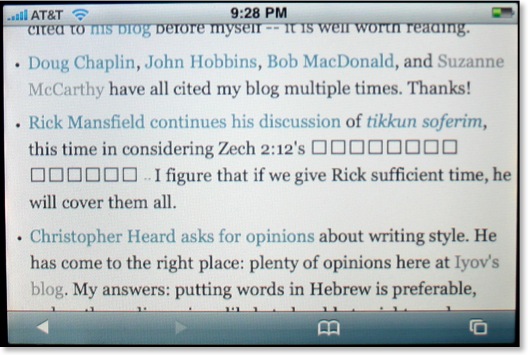
Sure enough--the Hebrew does not display at all.
So what about Greek? On Wednesday, Suzanne McCarthy posted an entry on the Better Bibles Blog titled "From Sapho 2." While not technically a biblical passage, the post includes Greek text. Here is another photo of my iPhone:
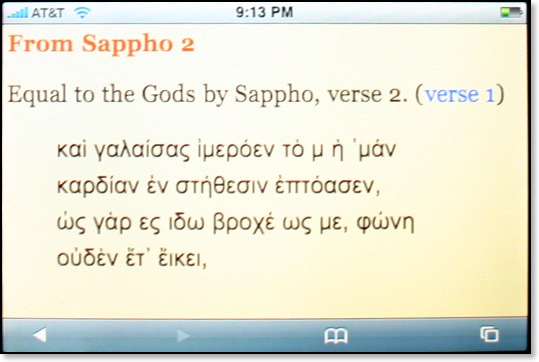
As you can see the Greek renders fine--in fact, it's perfect. So why doesn't the Hebrew? Modern Unicode fonts include characters for both Greek and Hebrew as well as quite a few other character language sets. My only conclusion is that iPhone v. 1 software uses limited font sets.
Hopefully, as the iPhone is introduced in other parts of the world, these missing languages--including Hebrew--will be added in.
As I said in my post yesterday reviewing Bible apps on the iPhone, I would like to eventually see original language biblical texts on the iPhone in addition to the English translations already available. So I decided to conduct a couple of tests on my own. If the iPhone won't display Hebrew, will it display Greek?
First, I wanted to confirm the lack of Hebrew character support, so I ran over to Iyov's blog where I remember he used some Hebrew fonts last Monday in regard to a post by yours truly. Below is an actual photograph of my iPhone screen on Iyov's post "Brief Notes (Rosh Chodesh Av, 5767)":

Sure enough--the Hebrew does not display at all.
So what about Greek? On Wednesday, Suzanne McCarthy posted an entry on the Better Bibles Blog titled "From Sapho 2." While not technically a biblical passage, the post includes Greek text. Here is another photo of my iPhone:

As you can see the Greek renders fine--in fact, it's perfect. So why doesn't the Hebrew? Modern Unicode fonts include characters for both Greek and Hebrew as well as quite a few other character language sets. My only conclusion is that iPhone v. 1 software uses limited font sets.
Hopefully, as the iPhone is introduced in other parts of the world, these missing languages--including Hebrew--will be added in.
A Lame Dance (1 Kings 18:26)
07/29/2006 14:06 Filed in: Faith & Reason
NOTE: Tables in this blog entry do not render correctly in Internet Explorer 6 for Windows.
In reading the showdown between Elijah and the priests of Baal today, I noticed a rather unusual expression in the Holman Christian Standard Bible's rendering of 1Kings 18:26--
"So they took the bull that he gave them, prepared it, and called on the name of Baal from morning until noon, saying, 'Baal, answer us!' But there was no sound; no one answered. Then they did their lame dance around the altar they had made" [emphasis added].
"Lame dance" is what caught my eye. I am used to reading that they "leaped" around the altar. Below is a table with a number of translations represented. Originally, I was going to include the Hebrew from the BHS, but I am having trouble getting it to display correctly in the table. Nevertheless, the key phrase of importance is וַֽיְפַסְּח֔וּ עַל־הַמִּזְבֵּ֖חַ אֲשֶׁ֥ר עָשָֽׂה׃ and I have emphasized that in bold in the table below:
What we see here is that the KJV and NASB95 translate פסח/pasach as "leap" while the RSV/NRSV/ESV tradition uses "limped," NIV/TNIV uses "danced," and the HCSB and NLT seem to combine the concepts of dancing and limping (or "hobbling" in the NLT).
According to the Koehler-Baumgartner Hebrew lexicon, פסח/pasach, when used in the piel form as it is in this verse, conveys the meaning, "to limp about in a cultic ceremony, perform a hobbling dance." While the RSV/NRSV/ESV tradition seems to improve upon the rendering in the KJV and NASB, only the HCSB and NLT incorporate both connotations of dancing and limping/hobbling. I'm not exactly sure what this shuffling dance was like, but it was obviously not ballet. Incidentally, the first edition of the NLT (1996) renders פסח/pasach as "danced wildly," perhaps borrowing from the NEB/REB, but this phrase does not quite capture the meaning of the word either.
I should note, too that the writer of 1 Kings is making a play on words regarding the actions of the priests of Baal. The same word is used in the Hebrew in v. 21 when Elijah asks the Israelites how long they will go on pasach-ing between two opinions. Of the English translations mentioned above, only the RSV/NRSV/ESV and the NLT make the connection of this pun in English, something very difficult to catch outside the Hebrew.
Regardless, except for the HCSB and NLT, most translations do not accurately convey both the dancing and limping elements of פסח/pasach. Perhaps this is a good example as to why sometimes a literal word-for-word translation method is less than effective in conveying the meaning of the original text.
And while the rendering "lame dance" in the HCSB caught my attention, I have to admit that I misread the verse. Lame can mean "unable to walk" or it can mean "ineffective or weak."
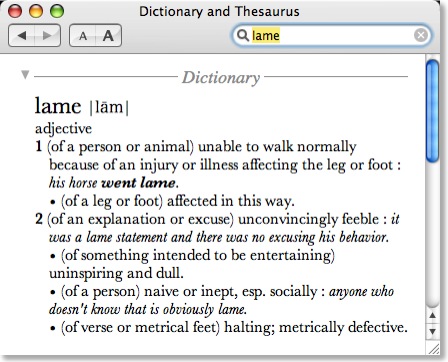
When I read, "They did their lame dance..." I mentally heard the voice of one of the high school students I used to teach saying, "That's so lame" about something he thought was stupid. Now while we might agree that the dance performed by the priests of Baal was ineffective and stupid, and perhaps we might have used the same sentiment as the high school student had we been there, this idea of lame is not what the writer of 1 Kings had in mind. Therefore, I have to assert that the HCSB, while attempting to convey the full meaning of פסח/pasach, falls a bit short because the reading might easily be interpreted as contemporary slang. This reminds me of the decision on the part of the CEV translators to avoid using the word "awesome" for God because of how it is so often misappropriated and overused among teenagers.
In the end, I'll have to conclude that the NLT's rendering is the most accurate: "Then they danced, hobbling around the altar they had made." I still don't know exactly what this dance looked like but I tried to demonstrate my best guess to Kathy. I'm sure my presentation was as comical to her as the priests of Baal's dance was to Elijah. And she agreed, it was lame...
In reading the showdown between Elijah and the priests of Baal today, I noticed a rather unusual expression in the Holman Christian Standard Bible's rendering of 1Kings 18:26--
"So they took the bull that he gave them, prepared it, and called on the name of Baal from morning until noon, saying, 'Baal, answer us!' But there was no sound; no one answered. Then they did their lame dance around the altar they had made" [emphasis added].
"Lame dance" is what caught my eye. I am used to reading that they "leaped" around the altar. Below is a table with a number of translations represented. Originally, I was going to include the Hebrew from the BHS, but I am having trouble getting it to display correctly in the table. Nevertheless, the key phrase of importance is וַֽיְפַסְּח֔וּ עַל־הַמִּזְבֵּ֖חַ אֲשֶׁ֥ר עָשָֽׂה׃ and I have emphasized that in bold in the table below:
| 1 KINGS 18:26 | |||
|---|---|---|---|
KJV |
RSV |
NRSV |
NASB95 |
| And they took the bullock which was given them, and they dressed it, and called on the name of Baal from morning even until noon, saying, O Baal, hear us. But there was no voice, nor any that answered. And they leaped upon the altar which was made. | And they took the bull which was given them, and they prepared it, and called on the name of Ba'al from morning until noon, saying, "O Ba'al, answer us!" But there was no voice, and no one answered. And they limped about the altar which they had made. | So they took the bull that was given them, prepared it, and called on the name of Baal from morning until noon, crying, “O Baal, answer us!” But there was no voice, and no answer. They limped about the altar that they had made. | Then they took the ox which was given them and they prepared it and called on the name of Baal from morning until noon saying, “O Baal, answer us.” But there was no voice and no one answered. And they leaped about the altar which they made. |
HCSB |
ESV |
NLT2 |
TNIV |
| So they took the bull that he gave them, prepared it, and called on the name of Baal from morning until noon, saying, “Baal, answer us!” But there was no sound; no one answered. Then they did their lame dance around the altar they had made. | And they took the bull that was given them, and they prepared it and called upon the name of Baal from morning until noon, saying, “O Baal, answer us!” But there was no voice, and no one answered. And they limped around the altar that they had made. | So they prepared one of the bulls and placed it on the altar. Then they called on the name of Baal from morning until noontime, shouting, “O Baal, answer us!” But there was no reply of any kind. Then they danced, hobbling around the altar they had made. | So they took the bull given them and prepared it. ¶ Then they called on the name of Baal from morning till noon. “Baal, answer us!” they shouted. But there was no response; no one answered. And they danced around the altar they had made. |
What we see here is that the KJV and NASB95 translate פסח/pasach as "leap" while the RSV/NRSV/ESV tradition uses "limped," NIV/TNIV uses "danced," and the HCSB and NLT seem to combine the concepts of dancing and limping (or "hobbling" in the NLT).
According to the Koehler-Baumgartner Hebrew lexicon, פסח/pasach, when used in the piel form as it is in this verse, conveys the meaning, "to limp about in a cultic ceremony, perform a hobbling dance." While the RSV/NRSV/ESV tradition seems to improve upon the rendering in the KJV and NASB, only the HCSB and NLT incorporate both connotations of dancing and limping/hobbling. I'm not exactly sure what this shuffling dance was like, but it was obviously not ballet. Incidentally, the first edition of the NLT (1996) renders פסח/pasach as "danced wildly," perhaps borrowing from the NEB/REB, but this phrase does not quite capture the meaning of the word either.
I should note, too that the writer of 1 Kings is making a play on words regarding the actions of the priests of Baal. The same word is used in the Hebrew in v. 21 when Elijah asks the Israelites how long they will go on pasach-ing between two opinions. Of the English translations mentioned above, only the RSV/NRSV/ESV and the NLT make the connection of this pun in English, something very difficult to catch outside the Hebrew.
Regardless, except for the HCSB and NLT, most translations do not accurately convey both the dancing and limping elements of פסח/pasach. Perhaps this is a good example as to why sometimes a literal word-for-word translation method is less than effective in conveying the meaning of the original text.
And while the rendering "lame dance" in the HCSB caught my attention, I have to admit that I misread the verse. Lame can mean "unable to walk" or it can mean "ineffective or weak."

When I read, "They did their lame dance..." I mentally heard the voice of one of the high school students I used to teach saying, "That's so lame" about something he thought was stupid. Now while we might agree that the dance performed by the priests of Baal was ineffective and stupid, and perhaps we might have used the same sentiment as the high school student had we been there, this idea of lame is not what the writer of 1 Kings had in mind. Therefore, I have to assert that the HCSB, while attempting to convey the full meaning of פסח/pasach, falls a bit short because the reading might easily be interpreted as contemporary slang. This reminds me of the decision on the part of the CEV translators to avoid using the word "awesome" for God because of how it is so often misappropriated and overused among teenagers.
In the end, I'll have to conclude that the NLT's rendering is the most accurate: "Then they danced, hobbling around the altar they had made." I still don't know exactly what this dance looked like but I tried to demonstrate my best guess to Kathy. I'm sure my presentation was as comical to her as the priests of Baal's dance was to Elijah. And she agreed, it was lame...









